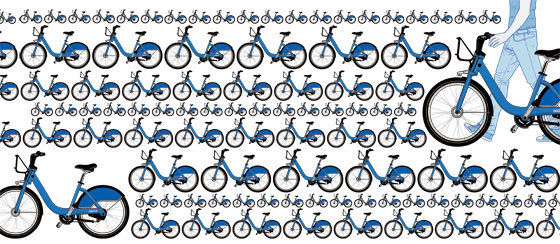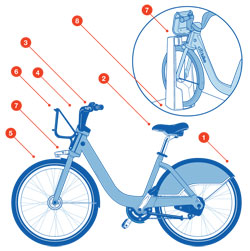
You might notice communal bike stations in other cities and think “What a great idea!,” then forget about it and take a cab. Beginning July 31, though, Citi Bike, New York’s new bike-sharing program featuring 600 stations and 10,000 two-wheelers in select neighborhoods, will be impossible to ignore. While other towns’ shares have proved successful, hiccups are not unheard of: Riders in Australia cursed compulsory-helmet laws and D.C. bikers bemoaned the scarcity of stations. The New York system was designed with those shortcomings in mind and will “cover the right density and area to be successful,” according to Alison Cohen, president of Alta Bicycle Share, the company that owns Citi Bike. The initial rollout consists of 420 stations and 7,000 bikes, and while most shares operate on some combination of public and private funding, Citi Bike is the world’s first to launch with fully private sponsorship.

Anatomy of a Blue Bike
1. “The minute you start rolling, the front and rear lights come on,” says NYC DOT bike-share program director Kate Fillin-Yeh. A capacitor in the hub keeps them on even when wheels stop (say, at a red light).
2. The adjustable seat fits people from four-foot-eight to six-foot-eight.
3. New York law requires that all bikes have bells. The Citi Bike’s bell is built in.
4. The GPS and radio-frequency tag transmits data for every trip, much like the GPS system for the city’s yellow cabs. The data will be used to plan improvements, like adjustments in station locations and bike-lane expansion.
5. Fortified for 24/7 city riding, each bike is fitted with heavy-duty tires and weighs about 40 pounds. Says Fillin-Yeh, “It’s a big bike the first 30 seconds you’re on it.”
6. A rack in the front has a cord to secure backpacks, purses, or laptops.
7. The mechanical titanium lock sends pins into the docked bike: “It’s pretty much bombproof,” says Jon Orcutt, senior policy adviser at the DOT.
8. The D.C.-station model was redesigned for New York to better blend in with the city’s existing “street furniture,” like bus shelters.
• The modular stations install quickly with no digging or roadwork. “We were running demos last fall and installing them in 30 to 45 minutes,” says Orcutt. Detailed planning ensured local businesses wouldn’t be disrupted.
• Alta installed solar-power poles in the stations that collect both direct and reflected light from 360 degrees, making them twice as efficient as ones in other cities.
• Most payments can be made at the kiosk, so that all riders have to do at the docking point is swipe a key or enter a five-digit access code.
How It All Works
Who runs this operation?
Alta owns it, Citibank and MasterCard sponsor it, and the DOT oversees it.
How do you pay?
This program was designed for short-distance commutes (under three miles), so there is a 30-to-45-minute usage time cap, depending on your chosen payment plan: A 24-hour pass is $10, a seven-day pass is $25, and an annual pass is $95. Overtime fees start at $2.50.
Are the stations uniform?
No. A residential area might have a 23-bike dock; the area around Grand Central station might host 120 bikes.
What if the station is full and there’s nowhere to park?
Enter your access code at the kiosk, which gives you a fifteen-minute grace period and provides directions to the nearest available station. Typically stations are spaced five blocks or fewer apart.
Is Alta concerned about new riders getting hurt?
Alta officials say they haven’t seen a single death in an estimated 25 million rides. But in Paris, at least seven riders have died since that program’s 2007 launch. French officials responded to a 2008 death by instituting a citywide safety campaign.
What’s to keep the bikes from being stripped?
Parts are specialized, so they have no independent resale value and can’t be removed with traditional tools.
What about theft?
These stations are hard-core. When the Montreal system launched, people tried to drag out docked bikes with a truck and failed.
And after I’ve unlocked it?
There’s a $1,000 fee for lost or stolen bikes, but if you get mugged and file a report you won’t be charged.
Will 10,000 more bikes change the traffic dynamic?
Maybe eventually, but for now, Orcutt says, “It’s New York City. We have 5 million subway riders, 2 million bus riders [a day]. It’ll be visible but not overwhelming.”